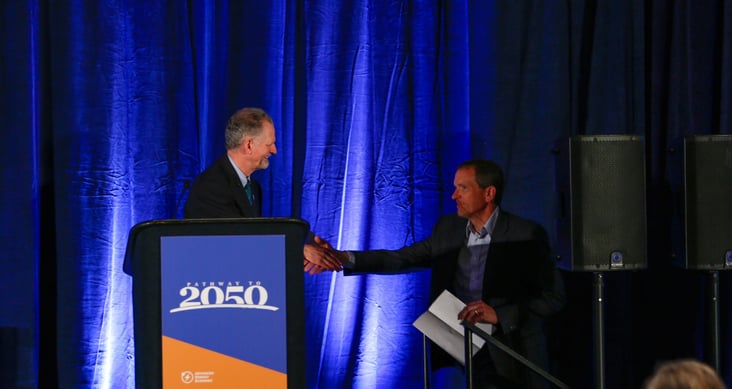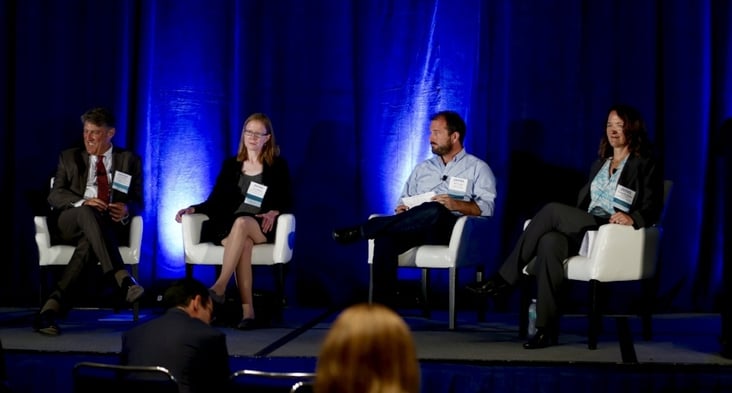
California has taken another big step toward its advanced energy future, as the legislature approved the state’s next target for greenhouse gas reductions – 40% by 2030. Not to take credit, but that action took place just two weeks after an AEE delegation, with representatives of 26 member companies, visited 40 legislative offices urging lawmakers to set the 2030 target and extend the cap-and-trade allowance system to get there – though extending cap-and-trade will have to wait until next year.
The lobby day on August 10 was the action component of AEE’s two-day stand in Sacramento, followed as it was by our fourth annual Pathway to 2050 conference. Pathway provided a full day for issues like SB 350 implementation, cap-and-trade, corporate renewables procurement, CPUC reform, California ISO regional expansion, and vehicle electrification to get chewed over by industry leaders, legislators, regulators, and the media. The purpose of these discussions is to clarify policy pathways to an advanced energy economy that the industry can get behind.
“When businesses get behind a policy, change happens,” said board member Kevin Self of Schneider Electric, kicking off the conference. “AEE is that business voice of advanced energy.”
“Climate policy is energy policy, and energy policy is climate policy,” said California Air Resources Board chair Mary Nichols, in a mainstage conversation with former Colorado governor Bill Ritter, director of the Center for the New Energy Economy at Colorado State University. Just a week earlier, California became the first state to submit its compliance plan for the Clean Power Plan to the U.S. Environmental Protection Agency. Nichols called the California submittal a “shot in the arm” for the federal rule, enforcement of which has been stayed pending the outcome of litigation to stop it.
As she said this at Pathway, on August 11, the fate of California’s own climate policy was far from certain. California was well on the way to meeting the 2020 target of greenhouse gas emissions reduced to 1990 levels set by the original climate law, AB 32, in 2006, and with no subsequent target in place, auctions for emission allowances under the state’s cap-and-trade system were foundering. Gov. Brown and the advanced energy industry, along with environmental advocates, were pushing, but it was not clear that there were votes in the Assembly to pass SB 32 and its 40%-by-2030 goal, though it did, ultimately, on a 48-31 vote, followed by the Senate, voting 25-13.
The legislative tension around SB 32 was a focus of the panel of media commentators, a first for Pathway. “This is a state that really has taken the lead on environmental issues, but none of it’s been easy,” said Dan Morain, editorial page editor and political columnist for the Sacramento Bee. “This year it’s going to be the same; there’s two weeks left in the legislative session. It’s very unclear that SB 32 will pass this year. Then it becomes very serious brinkmanship.”

Media panel at Pathway to 2050 featuring Dan Morain of the Sacramento Bee, Kate Galbraith of the San Francisco Chronicle, Jeff St. John of Greentech Media, and Cassandra Sweet of the Wall Street Journal.
“I think cap-and-trade will survive,” as both part of California’s climate policies and as a compliance mechanism for the Clean Power Plan, said Cassandra Sweet of the Wall Street Journal. Utilities, she said, “have to plan a decade ahead,” and they are “gravitating toward cleaner energy.”
Jeff St. John, senior editor of Greentech Media, noted that the big changes under way as the electric power system integrates more variable and distributed energy resources has the California Public Utility Commission (CPUC) “doing two dozen things simultaneously…each of them inter-related to each other.”
On regional expansion of California’s ISO, Kate Galbraith, assistant business editor of the San Francisco Chronicle, said this: “I used to work in Austin. I was on a bus tour of West Texas energy sites and someone said, ‘There are three grids in U.S. – East, West, and Texas.’ The bus burst into cheers. Here it’s totally different. But is Wyoming going to be that keen on joining California? There’s a difficulty there.”
Many other issues facing California on its pathway to 2050 were discussed by industry leaders and public officials over the course of the day. Assembly member Mike Gatto and CPUC President Michael Picker talked CPUC reform, with legislation sponsored by Gatto providing measures to restore public confidence in the regulatory body. Though saying “this legislative process has helped to move us farther along,” Picker saw challenges remaining: “What are processes that more people can participate in? These are broad issues where people crave more opportunity to participate. We can’t function unless we have a more open set of discussions.” (See also the blog post on this conversation by Pathway sponsor Davis Wright Tremaine LLP.)
The Pathway crowd of nearly 350 registrants also heard from two big companies about the corporate push to purchase renewable energy directly, rather than relying on the grid to improve its fuel mix. “2016 is about bringing in new players” to corporate renewable energy procurement, said Brian Janous, director of energy strategy for Microsoft. “Electricity consumption of the internet is equivalent to the third largest country on earth,” noted Patrick Flynn, sustainability director for Salesforce. It’s the job of leading companies like Microsoft and Salesforce to be “influencing more companies to enter into” agreements that get renewable energy projects built and “streamlining the process to get them through the funnel,” he said.
AEE board member Howard Wenger of SunPower talked with Southern California Edison President Ron Nichols about cooperation as tensions are building between utilities and solar providers in many parts of the country. “Are worlds colliding? In California, they’re converging,” said Nichols. At no time has it been as exciting as it is now. We want to embrace that change and work with it. We think there’s a great opportunity to partner.”
In another first for Pathway, AEE bestowed “Pathway Pioneers” awards to Senate President Pro-Tem Kevin de Léon and Sen. Fran Pavley, author of both AB 32 when she was in the Assembly and the just-passed SB 32.
Wrapping up Pathway for 2016 with an overview of California’s energy vision for 2050, California Energy Commissioner David Hochschild declared, “The grand California clean energy experiment is working.”
For more from Pathway, check out photos, videos of mainstage conversations, and audio recordings of breakout sessions on transportation, storage, and the water-energy nexus here, as well as a Storify of the social-media play-by-play and commentary from the Pathway floor that took place throughout the day.
Learn more about the jobs advanced energy is bringing to the Golden State in AEE Institute's recent report on Advanced Energy Jobs in California.
